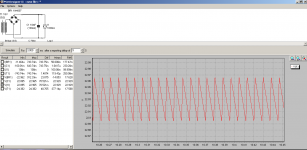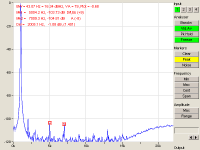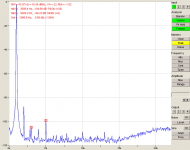Fas42, it is a mix of two things. A degraded dynamic on the transients, due to magnetic tape losses with age, plus little details hidden by the distortions and noise of the vinyls and revealed by the 'no vinyl' digital copy (with no intention).
All that makes the song to sound far away from what the original producers *wanted*.
Even if we could find a perfect sample of the tapes as it was at this time, all those tunes would need a new *mix* to be adapted to the modern listening systems and audience actual taste.
Not only restoration.
A crime of lese-majesty that only the original artist would be allowed to do.
That you can try on your side and for yourself only, of course.
"real muso's doing their thing in the studio" do not exists. Every instrument is "produced", compressed or expanded, noise gated, equalized, with the add of artificial reverberations and effects like flanges, delays, vocoders, hamonizers etc. during the mixing session. Even live performances recorded on multi tracks.
And, if you believe sometimes in the magic of musicians just playing together (and in tune in a real space, credit-it to the talent of sound engineers/producers.
in a real space, credit-it to the talent of sound engineers/producers.
All that makes the song to sound far away from what the original producers *wanted*.
Even if we could find a perfect sample of the tapes as it was at this time, all those tunes would need a new *mix* to be adapted to the modern listening systems and audience actual taste.
Not only restoration.
A crime of lese-majesty that only the original artist would be allowed to do.
That you can try on your side and for yourself only, of course.
"real muso's doing their thing in the studio" do not exists. Every instrument is "produced", compressed or expanded, noise gated, equalized, with the add of artificial reverberations and effects like flanges, delays, vocoders, hamonizers etc. during the mixing session. Even live performances recorded on multi tracks.
And, if you believe sometimes in the magic of musicians just playing together (and in tune
Last edited:
I can "see" a future where the real, raw takes of any musical performance are available for the consumer to reassemble as they wish. The producer becomes a thing of the past, so to speak.
So Adele: put together your pure, pristine, straight from the mic variation; or if a young kid you load it up with every spice and garnish, mangling "enhancement" available -- the consumer is in control ...
Frank
So Adele: put together your pure, pristine, straight from the mic variation; or if a young kid you load it up with every spice and garnish, mangling "enhancement" available -- the consumer is in control ...
Frank
In a way, i would love to can remix according to my taste and actual ability some of my old work.
In an other way, the sound of a record is a part of the creation, and that's why it will never happen, i think. Plus the fact, that musicians or singers would not agree at all that people can hear some parts of the original takes, see what i mean ?
In an other way, the sound of a record is a part of the creation, and that's why it will never happen, i think. Plus the fact, that musicians or singers would not agree at all that people can hear some parts of the original takes, see what i mean ?
I agree Chriostophe that what the musicians and recording engineer put down should be considered a formal piece of music that only those people should be able to change.
Now that being said I have seen so many audio programs that will do just about anything you would want to do to a piece of music if that is what you truly want to do. Of course you are doing all of this in a digital format on a computer but so what. Last time I was in a studio everything was streaming over to the Apple computer running Pro Tools or whatever software. Your just talking about the same thing, but you are doing post production for your personal sound.
Go for it, I will just listen to the original and leave it to a little eq now and then. If I don't like that then I won't listen to an album that I just don't enjoy the mix. Just like in the days of vinyl there were albums that you just didn't like, take it for what it is worth, sometimes you just don't agree with the recording engineers mix or the sound that the artist was after for some personal reason. That is part of what makes the experience of music so individual, we all like something different.
Now that being said I have seen so many audio programs that will do just about anything you would want to do to a piece of music if that is what you truly want to do. Of course you are doing all of this in a digital format on a computer but so what. Last time I was in a studio everything was streaming over to the Apple computer running Pro Tools or whatever software. Your just talking about the same thing, but you are doing post production for your personal sound.
Go for it, I will just listen to the original and leave it to a little eq now and then. If I don't like that then I won't listen to an album that I just don't enjoy the mix. Just like in the days of vinyl there were albums that you just didn't like, take it for what it is worth, sometimes you just don't agree with the recording engineers mix or the sound that the artist was after for some personal reason. That is part of what makes the experience of music so individual, we all like something different.
What I like best is the 1966 voltage regulators made by National. They were quieter than almost anything, today!
Must be out of this world, since National did not start making semiconductors until 1969.
LM723 is a neat device but it needs a lot of support compared to an LM317. They are still used in the linear power supply modules from Power One etc.
LM723 is a neat device but it needs a lot of support compared to an LM317. They are still used in the linear power supply modules from Power One etc.
Amazing longevity. I used them back when they were Fairchild's uA723. Really not all that much to them.
Must be out of this world, since National did not start making semiconductors until 1969.
LM723 is a neat device but it needs a lot of support compared to an LM317. They are still used in the linear power supply modules from Power One etc.
See, no noise at all!
I wonder how many process changes have been made to these golden oldies. The part number may be the same, but it reminds me of 2N3055.
Amazing longevity. I used them back when they were Fairchild's uA723. Really not all that much to them.
It's the reference that is really quiet - about 7uV IIRC. And, you can decouple it easily so it really is low noise. The LM3xx are about 30uV/V of output, to a 15V output has nearly half a mV of noise.
PS Your first reference supports a .01F capacitor rising impedance as low as 3K! So does the 4th cite. The other two refer to filtering switching power supplies.
Irrelevant- what's the actual impedance? Sheesh. And the references don't actually say that, but don't let that get in the way.
Take a look at Fig 4.9 in Morgan Jones's book- he actually measured a cheap 10,000uF aluminum cap. The impedance at 6kHz was a whole 2 milliohms. Self resonance frequency is 15kHz, but the impedance at 100kHz is 8 milliohms. My bridge isn't quite as good as his, but I was able to confirm that the ESL of the cheap 10,000uF/35V (I didn't have any 25V units on hand) aluminum caps in my stock is about 10nH.
You indeed did the calculation, plugging in incorrect numbers and ignoring scaling factors. I went through that pretty thoroughly so that anyone could follow, not going to bother to do so again. There's a reason that 797 based preamps are dead quiet. Even if you dispute the widely-known-accurate PSUD2 sim, you're taking the difference between -250dB and -244dB noise. Seriously?
The rodeo clown act for John's benefit gets old. His claims are still false no matter how much dust you try to kick up.
edit: Here's my "work" to show the actual ripple. Plugging in values for components I had on hand, I find that my 120mV estimate was indeed too high- it's ~70mV p-p. Makes the concern even more ridiculous. PSUD2 is a "known-good" sim- I'm not a big believer in sim software, but again and again, it's given me (and thousands of other users) accurate results.
Attachments
AD797 needs careful el. design, which was not followed in the JC2 phono stage, attached by Richard. Especially supply rail bypassing. As it is an input stage and BJT, I would definitely add at least some RC filter, though there might be a small noise increase.. The BJT input connected directly to input connector is WRONG. I also do not think much about output loading/bias by the JFET. The further stages are adding unnecessary noise.
In an other thread, L.C, (a talented designer) tried to improve its nice SSA (A current feed-back power amp). He raised the VAS gain by 10/15dB. This increase, of course, the local distortion a lot, but increase the global feedback ratio. He report an obvious improvement in listening experience of the same amp.
One more testimonial in favor of global feedback advantages with fast devices.
One more testimonial in favor of global feedback advantages with fast devices.
As it is an input stage and BJT, I would definitely add at least some RC filter, though there might be a small noise increase.
Anti-RFI? Why not a small inductor? Less noise.
Yes, high bandwidth stages (IC or not) need good local bypassing.
Anti-RFI? Why not a small inductor? Less noise.
Yes, if the whole circuit stable. Bypassing - the recommendation for AD797 is in the datasheet.
Why RFI? Detection and demodulation in high gain BJT stages. Quite often in phono preamps with BJT input opamps.
... at -10zilliondB even from 5 miles out ...
Some 7th in a "real world" circuit:
Some years ago I tried different opamps in the input stage
of a Sony A6 DAT recorder.
Except for the LM4562 (second picture) all opamps tried (AD8620 here as an
example) showed clearly visible 7th.
Attachments
no matter how much dust you try to kick up
SY
Although there is some noise raised over some minor issues, Ed is not acting the way you said. I refuse to assign such intentions to him.
Besides, he is not gifted enough for that.
Trust me. I have gained vast experience living in this country where the art of camouflage dust spreading has been refined to a high degree.
PSUD2 is indeed a fine SW tool.
PSUD2
I have verified (when modelling is performed with care to details) it’s accuracy to uV level on dynamic Vs and Is through measurements on actual circuits.
For me the noise numerals is not an issue when noise is real noise (no certain frequencies raising their head and it’s level is relative stable).
It can turn into a problem if and when it’s amplitude and/or frequency envelope changes dynamically with (modulated or excited by) the signal.
I would appreciate if some of you knowledgeable participants can list possible mechanisms for such an effect.
For my level of capabilities, discussing effect levels below say –130db rel signal will be of academic interest only but still welcome.
George
Last edited:
Except for the LM4562 (second picture) all opamps tried (AD8620 here as an example) showed clearly visible 7th.
So you listen with your eyes?
Sorry, couldn't resist that one...
I am puzzled by your post though.
I agreed that it exists. I questioned the audibility at extremely low levels.
Now you come along to proof it exists.
So do you actually agree with me or what?
jan
In an other thread, L.C, (a talented designer) tried to improve its nice SSA (A current feed-back power amp). He raised the VAS gain by 10/15dB. This increase, of course, the local distortion a lot, but increase the global feedback ratio. He report an obvious improvement in listening experience of the same amp.
One more testimonial in favor of global feedback advantages with fast devices.
I agree with B. Putzeys wrt GNFB - if you are gonna use it, use a lot of it.
I prefer not to
... I questioned the audibility at extremely low levels.
I do not want to enter a discussion about the audibility of the 7th harmonic, but just
wanted to show that in real circuits (as opposed to datasheets with measurements at
unity gain) it´s obviously there. If -105 dB (not "-10zilliondB") for high order harmonics is an "extremely low level" or already to high is debatable of course. A line stage I´ve built based on Johns
JC-2 (ML-1) circuit doesn´t show anything above the third as a matter of fact.
Last edited:
I questioned the audibility at extremely low levels.
Read your own bookzine?
- Status
- Not open for further replies.
- Home
- Member Areas
- The Lounge
- John Curl's Blowtorch preamplifier part II


